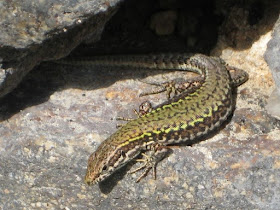Dear George,
I frequently walk down our street to the public library which is about six blocks away. In the middle of my journey I run across some cute little creatures sunning on the sidewalk who dart away into the grass as I approach. I thought they were salamanders, but it turns out that they are European wall lizards (or common wall lizards). In Cincinnati they’re called “Lazarus Lizards” (more about this below). I’ve been seeing these little guys for years, but this spring I was surprised (actually very pleased) to discover that they’ve moved down the street to our patio and driveway. Despite being in a big city, we have lots of wildlife in our yard — even deer at times — and I’m happy to welcome our new Lazarus Lizards. Here’s a poem in their honor and a few facts too.
Lazarus Lizards
We have brand new pets on our patio
They’re skinny and green with the longest tails
They look to be eight hundred million years old
Older than meerkats or hippos or whales
Lazarus Lizards are our new pets’ name
Brought to Cincy by a twelve-year old boy
Born in Italy, they’ve gained local fame
Like Fiona, they give me much joy
Our lizards enjoy sitting out in the sun
They patiently wait, to entice an ant
I snuck up, attempted to capture one
So quick, off it went, disappeared in a plant
Since we lost our dogs my heart has been sad
But with Lazarus Lizards, life’s isn’t half bad
There are literally millions of Lazarus Lizards in Cincinnati, spread throughout the entire city and, from there, infiltrating parts of Northern Kentucky and down the Ohio River to eastern Indiana. There are also colonies in British Columbia (escapees from a small zoo) and Long Island. Native to Europe, they always live around people, e.g., in rock walls, piles of wood, cracks or crevices in a house. Wall lizards grow up to seven inches in length; are green, gray, or brown in color; and have an angular head and long limbs and toes. There are several theories about the origins of wall lizards here, but the most widely accepted resulted when an elderly member of the local Lazarus department store family wrote to UC biologists who were studying the reptiles. In 1951 at age 12 George Rau, stepson of Fred and Irma Lazarus, was vacationing with his family in Lake Garda, Italy, about 80 miles east of Milan. He captured about ten local lizards, put them in a sock, and brought them back to their family home on Torrence Court in East Walnut Hills. (Torrence Court is now known as Lizard Hill.) Recently a UC biology graduate student has compared DNA samples from Cincinnati and Northern Italy, verifying their common ancestry. Moreover, the very low genetic diversity of the Cincinnati lizards indicated that as few as three had survived the migration, eventually producing the millions that exist today. Lazarus lizards have distinguishing features so that one can recognize individuals. They come out in the morning, once the sun has warmed the rocks (or patio tiles), and will sit an wait for an insect. While they’re very quick, they’re not skittish and sometimes humans can approach within a foot or two. I say hello to a Lazarus Lizard or two every morning, and they brighten up my day..
Love,
Dave
SOURCES:
www.cincinnati.com, “‘Imported’ lizard flourishing with few predators.” Mark Wert, Nov. 25, 2014.
www.cincinnati.com, “They came from Italy. Now, they outnumber us all.” Carol Motsinger, Aug 31, 2017.
www.wikipedia.org, Porarcis muralis. 
No comments:
Post a Comment